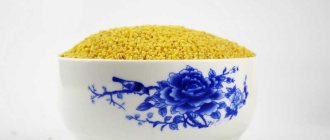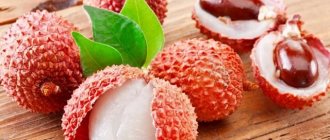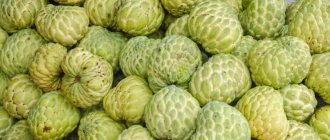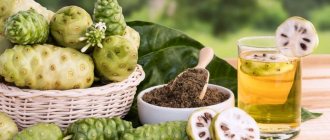What is carambola
The tropical fruit Carambola looks completely extraordinary: it vaguely resembles a heavily ribbed cucumber or even an airship. If you cut the fruit into transverse slices, each of them will have the shape of an almost regular five-pointed star - for this, carambola received other names - “star fruit” or “tropical star”.
The taste of carambola fruits is similar to green gooseberries, apples and cucumbers. Some varieties also have plum or grape notes.
Interesting fact: tourists traveling around Asia and America prefer to feast on sweet “star apples”, but in the tropics the most valuable are the types of carambola with sour fruits - they are better refreshing and quench thirst in hot climates.
How and where does the fruit grow?
The homeland of carambola is considered to be the Malaysian Peninsula and the countries of southeast Asia. In the wild, this plant is widely distributed throughout India and Sri Lanka. The star fruit has acclimatized quite successfully in countries such as Brazil, the USA, and Israel.
Carambola is a slow-growing evergreen tree, reaching a height of 5-9 meters in nature. Its dense crown is formed by many shoots and very long compound leaves that have an acacia-like shape. The plant blooms almost all year round with small bell flowers collected in clusters. Their petals are lilac, reddish or purple, the aroma is subtle and very pleasant.
The fruit type of carambola is berry. The fruits are small, weight 1 piece. – only about 70 g. The exotic fruit has a thin skin with massive ribbed growths. The peel of a ripe fruit can acquire various shades of yellow: from golden lemon to amber. The pulp is juicy, crispy, sweetish and slightly tart; it smells subtly of ripe apple, gooseberry and orange all at once.
Starfruit is quite easy to grow at home from seeds. The plant is not particularly demanding of care; you just need to provide it with good soil, regular watering and sufficient lighting. It will grow quite quickly in indoor conditions, however, it is almost impossible to get fruit from it when grown in this way.
Contraindications
The high concentration of oxalic acid makes this fruit dangerous for patients with stomach ulcers, enteritis and colitis. Although in the plant’s homeland it is actively used by nursing women to enhance lactation, an organism unaccustomed to exotics can react unpredictably. That is why exotic stars are not recommended for pregnant women and children under 7 years of age.
Chemical composition and calorie content
The biochemical composition of carambola fruits is incredibly diverse, it includes:
- vitamins and minerals: beta-carotene, ascorbic acid, B vitamins, phosphorus, calcium, potassium, magnesium, etc.;
- organic acids;
- sugars of natural origin;
- fiber, etc.
Nutritional value of tropical fruit per 100 g of ripe pulp:
- proteins – 1.1 g;
- fat – 0.3 g;
- carbohydrates – 3.9 g;
- water – 91 g.
This ratio of BZHU determines the rather low calorie content of carambola: it is only 31 kcal per 100 g of product.
Beneficial features
Thanks to the rich chemical composition of carambola, it is quite beneficial for human health. Its regular moderate use contributes to:
- strengthening the immune system;
- lowering blood pressure;
- normalization of digestion;
- removing excess fluid from tissues;
- relieving headaches, etc.
100 g of carambola fruit contains only 31 calories, so this fruit is quite acceptable to include in the diet of people trying to lose weight and following a healthy diet. It should be borne in mind that the beneficial properties of carambola are fully manifested only when eating ripe fruits that have ripened in natural conditions, and not in the refrigerator.
The medicinal properties of star fruit are widely used in Eastern and Ayurvedic medicine. Hemostatic, diuretic, wound-healing and other medicines are prepared from the fruits. The roots of the tree are used as an antidote for some poisonings, and the seeds have milk-producing properties.
Carambola - benefits
It is unlikely that any of our compatriots will actively use carambola for medicinal purposes - it is expensive and there are always more affordable, familiar analogues.
But where carambola grows, it is used to get rid of a variety of ailments and improve the general condition of the body.
1. Starfruit helps normalize the functioning of the reproductive system.
2. Relieves nausea and vomiting, toxicosis of pregnant women.
3. Helps relieve an asthmatic attack.
4. Stabilizes blood pressure.
5. Perfectly strengthens the nervous system.
6. Stimulates kidney function.
7. The fruit is useful for restoring the functioning of the stomach after suffering from diarrhea or poisoning.
8. For colds, carambola helps reduce the intensity of headaches and joint pain.
9. Participates in hematopoiesis processes, increases hemoglobin levels.
10. Treats hemorrhoids, relieves pain, stops bleeding.
11. Saves from vitamin deficiency.
12. Carambola has a positive effect on the condition of the skin. Its calming and antipruritic effect is especially valuable for chickenpox, eczema, and lichen.
13. Increases milk flow in nursing women.
14. Has a preventive effect - prevents heart disease, vascular disease, arthritis.
15. One of the best dietary fruits that help normalize weight.
Eating starfruit has a positive effect on mood, gives strength, and activates the body's hidden resources in difficult situations.
Possible harm and contraindications
Ripe carambola contains quite a lot of oxalic acid, so some diseases of the digestive organs are contraindications to its use: gastritis, enterocolitis, stomach and duodenal ulcers. The harmful oxalates present in the fruit may also pose a risk to people with complex kidney conditions.
Star apples can also harm human health if there is an individual intolerance to the individual components that make up them. An allergy to fruit usually manifests itself as skin rashes, nausea, weakness, indigestion, etc. To avoid an undesirable reaction of the body to an exotic fruit, it should be eaten in moderation. You should also not give carambola to infants, as it can cause serious digestive upset in them.
Pharmacological properties
Carambola fruits contain a huge amount of antioxidants. For example, polyphenolic flavonoids:
- gallic acid;
- quercetin;
- epicatechin.
They help the body get rid of free radicals, which has a beneficial effect on it. Fruits also have antimicrobial properties, meaning they kill some weak types of bacteria.
The fruits help the human nervous and digestive system. Thanks to thiamine, they are recommended for people who are prone to frequent stress and irritability.
Thanks to their bactericidal properties, the fruits help the body fight influenza, ARVI, and various mild colds.
For flu and colds, carambola is an effective remedy
Indications for use
The plant is used in the following cases:
- High blood pressure (carambola helps reduce).
- Presence of migraines.
- Heat.
- Problems with the nervous system, thyroid gland or skin.
- Cold.
- Vomit.
- Diarrhea and hemorrhoids.
The fruit also helps with ringworm and chickenpox.
Contraindications
But, unfortunately, behind all the advantages there are also disadvantages for a certain group of people.
For example, carambola is contraindicated for people suffering from ulcers of the gastrointestinal tract (stomach, duodenum, etc.) due to the high content of oxalic acid.
They can only taste the fruit, but under no circumstances overeat, as this can lead to disastrous consequences.
It should be avoided if you are allergic to it or have kidney failure, as it can disrupt salt metabolism. Sometimes there is personal intolerance, which manifests itself as diarrhea or vomiting.
Some people can consume carambola in limited quantities.
How to choose ripe fruits
To choose a carambola whose taste will definitely not disappoint you, you first need to look at the ribs of the fruit: in sweet ripe fruits they are fleshy, with a dark brown longitudinal stripe, “indicating” that the fruit is fully ripe on the tree branch. The aroma of ripe fruits is light, pleasant, slightly reminiscent of the smell of jasmine.
If you see a fruit with narrow, clearly separated ribs and pale green or yellowish skin, this is an unripe carambola. In this form, it is plucked from the branches for subsequent transportation to other countries. Only green fruits can be delivered to customers thousands of kilometers from the place of cultivation without loss of presentation and other consumer properties.
Carambola fruit. The benefits of carambola. How to choose carambola? How to eat carambola?
Carambola is an exotic fruit native to the hot tropics of Southeast Asia, India, and Indonesia. It grows quite successfully in the USA, Brazil, Israel, Thailand, Vietnam, and the Philippines. The carambola tree belongs to the evergreen family, sorrel or oxalis, its height can reach 12 meters.
exotic carambola has many names ! The popularity of this fruit in its homeland can be compared with apples, pears or cucumbers here.
Increasingly, it can be found and purchased in large supermarkets - carambola is loved and in demand not only among residents of exotic countries.
Useful properties and taste of carambola fruit
If you look at a photo of carambola , it is easy to notice that in appearance this fruit resembles a small golden or yellow airship - it has an elongated oval shape and pointed ribs.
Pictured is a carambola tree
Having made a transverse cut, you can see that the carambola fruit looks like a pointed star, for which it received all sorts of “star” names. The fruits, fully ripe on the tree, become almost transparent and glow in the sun like small lanterns.
Exotic carambola has a very low calorie content and low sugar level, so even the strictest diet will not prevent you from enjoying the wonderful taste of this fruit.
Its fruits are a real storehouse of useful substances for the body: minerals, vitamins, fiber. Carambola strengthens the immune system, saturates the body with vital vitamins in case of vitamin deficiency, helps cope with colds, and ensures the prevention of cardiovascular diseases.
Oxalic acid, which is found in large quantities in carambola, stimulates muscle function, stabilizes the nervous system, and helps the absorption of calcium.
However, this substance also has a dangerous effect: when consumed in large quantities, it can cause exacerbation of gastrointestinal diseases or lead to the formation of kidney stones.
So here, as in many things, it is worth observing moderation. Carambola quenches thirst very well, refreshes and energizes - no wonder it is so loved in the hot countries where it grows.
Numerous reviews of carambola speak for themselves: they compare its taste with everything: for some it resembles a banana or strawberry, for some they catch the citrus notes of kiwi or oranges, others talk about its resemblance to gooseberries, grapes or plums - it seems better Try it once rather than read a lot about this mysterious star fruit. In addition, different varieties have different flavors.
Ripe carambola tastes slightly sweet, with a slight sourness and a subtle spicy tint, it has a pleasant crunch, and its fruits are juicy - one might even say watery. The skin is thin and can also be eaten.
Unripe carambola tastes sour - they love to eat it in this form in the countries where it grows. Local residents believe that it retains more useful substances. Ripe sweet fruit is valued significantly less by them.
In the photo there are carambola flowers
How to eat carambola?
The easiest way to eat carambola without too much fuss is like an apple or cucumber - just bite pieces straight from the whole fruit. It is not at all necessary to prepare or cut it in any special way.
For convenience, larger fruits can be cut into pieces. There are several small seeds inside the carambola, so be careful and carefully remove them.
Carambola can be used as an addition to all kinds of desserts; it can be used to prepare sorbets, cocktails, jellies and puddings, make jam, and make candied fruits. Carambola acquires a special aroma if it is boiled in sugar syrup for several minutes.
Unripe fruit has interesting taste properties - in its qualities it is more like a vegetable, and there is no limit to imagination: it can be salted, pickled, prepared into sauces based on it, or added to vegetable stews.
Carambola is not only tasty, but also beautiful. Small stars can be used to decorate cakes, desserts and glasses with cocktails, and to make canapés. And simply cut into slices, the fruit will become a charming decoration on the holiday table.
How to choose carambola?
Unfortunately, only green carambola gets into our stores, otherwise there is no way to transport it. It ripens on site, in refrigerators. This, of course, slightly worsens its taste, but there are still some secrets that will help you choose a quality fruit.
- It is worth choosing smooth fruits without dents or damage. It would be better if they were a little harder; you shouldn’t buy soft ones.
- Ripe carambola has a bright yellow color, fleshy ribs with a dark brown stripe, and a slight scent reminiscent of jasmine.
- Unripe carambola has thinner and narrower ribs.
- Unripe fruit can be left in a warm place for a couple of days - it will quickly ripen in such conditions.
It is best to store carambola in a cool place. buy carambola in large chain hyper- and supermarkets, and you can easily find it in online stores - now it is found almost everywhere. They bring it to Russia from Thailand, Brazil, Indonesia, and Israel. The average price of carambola is 100-200 rubles per piece.
Growing carambola
Growing carambola at home is not so difficult - it adapts well to a warm apartment. It does not require a lot of light, the main thing is to take care of watering and regularly spray the leaves.
Carambola is planted from seeds, which must be taken from the ripest fresh fruit. They quickly lose their viability, so they cannot be stored. It is best to start growing carambola in February-March, at the end of winter.
Carambola at home
To begin with, the seeds are germinated in a warm, moist place, this can take up to three weeks, so you will have to be patient. Then the hatched sprouts are planted in small containers or directly in pots. Be sure to use drainage at the bottom of the container.
Carambola needs to be replanted regularly - it grows very quickly. The plant does not tolerate direct sunlight, which can damage its leaves - it is best to grow carambola in shaded corners of the apartment.
With good care and appropriate conditions, the tree is quite capable of bearing fruit and delighting with delicious exotic fruits.
How to preserve the freshness and taste of fruit
Almost all exotic fruits brought to our country are harvested unripe at home. If there is not much choice in the supermarket, but you still want to try the “tropical star,” you will have to be content with the offered assortment and buy green carambola. In this case, the fruit should be left for several days in a paper bag at room temperature to ripen. You should not expect that the taste of such a fruit will be as sweet as that ripened on a branch, but it is quite possible to get an idea of what this “star apple” is in this way.
Ripe fruits purchased on a trip to Asian countries must be stored in the refrigerator, otherwise they will quickly lose their presentation and taste. It is best to eat carambola immediately after purchase; the pulp of fresh fruits is much sweeter and juicier than those that were collected even a few days ago.
Carambola
A beautiful star-shaped fruit (if you cut carambola into slices) is simply created to decorate cocktails and desserts. In addition, it is tasty, sour, aromatic. Carambola is not sold in every supermarket, but it can be found where there is a wide selection of exotic fruits.
Carambola is often recommended on weight loss forums; it is considered a fruit that helps burn fat, is low in calories and rich in vitamins. But in large quantities, carambola can cause vomiting, convulsions, and weakness. And in severe cases - serious problems with the kidneys, even failure. Therefore, even small portions are contraindicated for those who have diseases of this organ. Healthy people are not recommended to eat carambola on an empty stomach and eat more than 1 piece per day. And it’s better to do this once a week.
Let us remind you that any useful product can be dangerous in large quantities. Nutritionists recommend eating 400 g of vegetables and fruits per day. This is literally a portion of a vegetable side dish, salad and a couple of small fruits. Any meal should not be very large, it is optimal to focus on your folded palms, mentally imagine such a portion of food (without a slide!). You also need to drink enough clean water and chew your food very well.
How to eat carambola
Ripe carambola fruits are eaten fresh with the peel. There is no need to peel them; before eating, you just need to wash the fruit well under running water. To serve the star fruit, it is cut across the ribs into thin slices. If you do this correctly, you will get beautiful “stars” that can be used to decorate any dessert, drink or main dish.
Application
In cooking, starfruit is usually used raw to make light desserts. Carambola fruits are also quite suitable for canning: they are used to make jams, preserves, and jellies. When cooked, the smell of the fruit “reveals” especially effectively - sweet and tart at the same time. Unripe fruits are more like vegetables - they are used to prepare side dishes for meat and fish, as well as a variety of salads, sauces, marinades and pickles. Carambola juice is added to cocktails - it gives the drinks a more refined and slightly tart taste.
Carambola is a tasty and healthy fruit that is very popular in its homeland. Today you can find these “star apples” in Russian supermarkets. If you have the opportunity to purchase and try them, be sure to take it. The taste and aroma of these unusual fruits can surprise and delight even experienced lovers of exotic fruits.
Application in cosmetology
Fragrant and healthy carambola is very popular in cosmetology. Tropical fruit oil is added to shampoos and shower gels, care products for aging skin and scrubs. Organic acids in the product help clean pores and eliminate inflammation, smooth out the first wrinkles.
We recommend reading: What are the benefits of soaked apples, how to prepare them for the winter
You can use fresh fruit pulp to care for the epidermis at home. It should be borne in mind that carambola can cause allergic reactions. Before the first use, it is recommended to apply a small amount of juice to the wrist or elbow and wait about a day. If irritation and redness do not occur, you can use carambola fruit to treat your facial skin.
Tonic for aging skin
Based on carambola, you can prepare a homemade tonic for dry skin prone to aging. The remedy is made like this:
- Place fresh carambola pulp into a blender and grind it to a paste.
- Squeeze out fruit juice through folded gauze.
- Pour the resulting liquid into ice molds and put it in the freezer.
You need to use cold cubes every morning to wipe your face. Use an ice cube to treat the skin along massage lines for 3-4 minutes, without staying in one place for more than a couple of seconds. With regular use of cold tonic, the epidermis acquires a healthy color, shallow wrinkles and morning swelling disappear.
Mask for oily skin
Organic acids in carambola have a strong cleansing effect. The tropical fruit is recommended for the care of oily skin prone to rashes. The simplest recipe for making a mask looks like this:
- Fresh carambola is washed and thoroughly ground in a blender or meat grinder.
- Distribute the pulp of the tropical fruit evenly over the washed face.
- Wash off the mask after 10-15 minutes.
- Treat the skin with nourishing cream.
Carambola helps cleanse pores of impurities and copes well with inflammation. If desired, the fruit pulp can be combined with sour cream and kefir, vegetable squeezes, and exfoliating ingredients.
Attention! Masks with carambola must be used at least twice a week. A single use of a tropical fruit will not give a pronounced cosmetic effect.
Carambola juice makes age spots less noticeable











